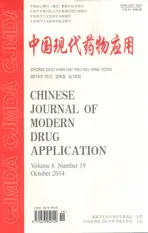终末期肾病维持性血液透析患者不同液体超负荷水平与心率变异性关系的研究
2014-07-18张小明李雪芬刘伟任姜汶田福华
张小明 李雪芬 刘伟 任姜汶 田福华
终末期肾病维持性血液透析患者不同液体超负荷水平与心率变异性关系的研究
张小明 李雪芬 刘伟 任姜汶 田福华
目的探讨终末期肾病维持性血液透析(maintenance hemodialysis, MHD)患者不同液体超负荷水平与心率变异性(heart rate variability, HRV)的关系。方法终末期肾病MHD患者60例, 根据透析期间患者体重增长情况, 将入选患者透析期间体重增长不超过5%的归入对照组, 共47例;因患者自身原因(透析不充分、饮水过多及气候变化等)透析期间体重增长超过5%的归入实验组, 共13例, 分析同一MHD患者透析后不同液体超负荷水平与HRV的关系。结果两组比较, 高频功率(high frequency, HF)差异无统计学意义(P>0.05), 低频功率(low frequency, LF)及R-R间期功率变异比值(LF/ HF)差异有统计学意义(P<0.05)。近似熵(ApEn)在透析前差异无统计学意义(P>0.05), 透析后差异有统计学意义(P<0.05)。结论透析期间控制液体负荷水平可能有助于心脏自主神经功能的改善。
血液透析;液体超负荷水平;心率变异性
血液透析是终末期肾病患者赖以生存的重要手段, 患者体内液体超负荷现象是MHD患者透析后的常见并发症之一,对患者的愈后及生存率密切相关[1-3]。临床观察发现, 透析患者体内液体超负荷水平与心率变异性有密切关系, 但目前尚没有相关文献报道。心率变异性是近年来比较受关注的无创性心电监测指标之一, 可用来预测心脏性猝死、评价心脏自主神经的活动性、均衡性及相关的病理状态[3-7]。本文旨在通过研究透析患者心率变异性中的频域指标, 探讨透析患者不同体液超负荷水平与心率变异性的关系。
1 资料与方法
1.1一般资料 选择2011年1月~2012年1月在九龙坡区第一人民医院肾内科血液净化中心透析治疗≥3个月, 年龄≥18岁的终末期肾病患者, 所有患者均签署知情同意书均病情稳定, 无急性心脑血管疾病, 3个月内未接受外科手术,无严重肝功能受损。
1.2研究方法
1.2.1分组 选择入组患者连续3个月记录每次血液透析中的体重, 并根据体重增长情况进行分组, 透析期间体重增长不超过5%的归入对照组, 透析期间体重增长超过5%的归入实验组。血液透析2~3次/周, 透析时间3.5~4 h/次,血流速度200~250 ml/min。普通肝素或低分子肝素抗凝。透析液配方:Na+138 mmol/L, K+2.0 mmol/L, Ca2+1.5 mmol/L, Mg2+1.5 mmol/L, 碳酸氢盐34 mmol/L。两组一般资料比较, 差异无统计学意义(P>0.05), 具有可比性。血样本在透析前抽取,以测定血色素(HGB)、血细胞比容(Hct)、尿素氮(BUN)和肌酐(Cr)水平。
1.2.2心率变异性检测 按照文献报道的标准方法进行[8]。采用美国GEMarquette公司生产的配备Holter-Star分析软件的Holter心电图扫描仪及三通道模拟V5、V1、avF 导联记录器进行24 h动态心电图分析, 于透析开始前监测所有患者的24 h动态心电图变化, 运用Holter-Star分析软件对HRV进行分析。瞬间R-R间期的突然变化视为干扰所致, 予以剔除。透析前30 min嘱患者平躺静卧, 分别在透析开始时、结束时以及透析过程中每30 min记录患者血压及心率。动态心电图自动记录整个血液透析过程中HRV的各个指标。对每一入选患者透析前后共24 h(以透析4 h为中心时间段)进行24 h动态心电图监测, 并分析主要的时域(SDNN、NN50)和频域HRV(VLF、LF/HF)指标, 每一入选患者观察连续3次血液透析的24 h动态心电图, 每3个月对所有入选患者按上述方法重复检测, 连续检测18个月。其中, 分析LF和HF需要使用标准化后的结果, 标准化LF和HF用LFn和HFn表示,由如下公式计算得出:LFn=LF/(TP-VLF)×100%;HFn=HF/ (TP-VLF)×100%;[TP=总功率(单位为ms2);VLF=极低频功率(单位为ms2)]。比较透析前后5 min两组非线性分析指标近似熵(ApEn), 计算公式为ApEn(r, m, n)=Φm(r)-Φm+1(r)。
1.3统计学方法 采用SPSS17.0统计软件进行统计学分析。计量资料以均数±标准差表示, 采用t检验;计数资料采用χ2检验。P<0.05为差异具有统计学意义。
2 结果
HF两组比较差异无统计学意义(P>0.05);但LF及LF/HF透析实验组较对照组显著降低(P<0.05);ApEn在透析前两组比较差异无统计学意义(P>0.05), 透析后差异有统计学意义(P<0.05)。见表1。
表1血液透析过程中平均心率变异性频域指标、非线性分析指标变化

表1血液透析过程中平均心率变异性频域指标、非线性分析指标变化
注:与对照组比较,aP<0.05,bP>0.05
组别例数LFn(nu)HFn(nu)LF/HFApEn透析前透析后实验组1356.01±2.33a39.55±1.88b2.12±0.33a1.07±0.14b0.90±0.17a对照组4761.13±1.6741.23±1.543.60±0.621.05±0.111.07±0.13 t 6.940.512.590.163.46 P 0.0080.610.0140.8760.001
3 讨论
HRV是反映自主神经系统活性和定量评估心脏交感神经与迷走神经张力及其平衡性, 从而判断其对心血管疾病的病情及预防的, 可能是预测心脏性猝死和心律失常性事件的一个有价值的指标。致命性的心律失常与交感神经的兴奋性增加、迷走神经的兴奋性减少有关, 自主神经系统活动的量化可以通过心率变化的程度表现出来, HRV代表了这样一种量化标测。即通过测量连续正常P-P间期变化的变异性来反映心率变化程度、规律, 从而用以判断其对心血管活动的影响。HRV降低为交感神经张力增高, 可降低室颤阈, 属不利因素;HRV升高为副交感神经张力增高, 提高室颤阈,属保护因素[3,7,8]。国内外报道, 终末期肾病患者的心血管疾病的发生率和由此导致的死亡率明显高于普通人群。随着肾功能的进行性损害, 慢性肾衰竭患者血肌酐和尿素氮亦进行性升高, 由此引起HRV不同程度的下降, 提示该类患者自主神经功能遭受不同程度的损伤[9-13]。然而, 维持性血液透析患者不同体液超负荷水平对HRV的影响, 目前尚不完全清楚。
众所周知, 维持性血液透析患者极易合并心血管疾病,主要是因为该类患者大多存在不同程度的自主神经系统功能紊乱, 尤其以交感神经系统功能亢进为主。透析过程中, 由于血管内进行脱水的原因, 会出现循环血容量减少和血压下降, 进而引起人体代偿机制。而外周血容量的减少会刺激颈动脉窦和主动脉弓压力感受器, 进而增强交感神经的兴奋性,使心率加快, 心肌收缩力增强, 同时使小动脉和容量血管收缩,防止垮血压的发生, 以此来维持正常的血流动力学状态[12-16]。另一方面, 由于血液透析患者自主神经调节功能存在不同程度的损害, 不能及时对快速体液丢失作出反应, 所有血液透析患者极易发生垮血压。国内外学者认为, HRV可较好的反映交感和副交感神经的功能水平以及相互间的平衡, 是评估自主神经功能的有效指标, 对患者的愈合也有一定的评估作用[3-7]。在本研究中, LF和HF分别反映交感神经和迷走神经的活性, LF/HF则代表交感和副交感神经的平衡。而计算出来的近似熵的大小反映系统复杂性的高低, 近似熵越大, 说明系统越趋近于随机状态, 包含频率成分越丰富, 具有较强的适应性;近似熵越低, 则信号越趋于周期性, 信号包含的频谱较窄, 系统的适应能力越低[17-20]。在心血管系统中, 心血管调节的模式常用近似熵表示, 近似熵的高低与心血管系统的复杂性呈正相关。国内外文献表明, MHD患者的HRV的所有参数均较正常值低[19,20]。本研究中, 观察到透析实验组较对照组LF、LF/HF值均降低, 说明MHD患者透析期间严格控制液体负荷水平可能有助于心脏自主神经功能的改善。
[1] Wizemann V, Wabel P, Chamney P, et al.The mortality risk of overhydration in haemodialysis patients.Nephrology Dialysis Transplantation, 2009, 24(5):1574-1579.
[2] Ronco C, Haapio M, House AA, et al.Cardiorenal syndrome.Journal of the American College of Cardiology, 2008, 52(19):1527-1539.
[3] Blankestijn PJ, Ligtenberg G.Volume-Independent Mechanisms of Hypertension in Hemodialysis Patients: Clinical Implications.Seminars in Dialysis, 2004, 17(4):265-269.
[4] Wabel P, Moissl U, Chamney P, et al.Towards improved cardiovascular management: the necessity of combining blood pressure and fluid overload.Nephrology Dialysis Transplantation, 2008, 23(9):2965-2971.
[5] Nalesso F, Ferrario M, Moissl U, et al.Body composition and heart rate variability to achieve dry weight and tolerance.Contrib Nephrol, 2011(171):181-186.
[6] Langewitz W, R üddel H, Schächinger H.Reduced parasympathetic cardiac control in patients with hypertension at rest and under mental stress.American heart journal, 1994, 127(1):122-128.
[7] Vesalainen RK.Vagal cardiac activity in essential Hypertension: the effects of metropol and rampinil.Am J of Hypertension, 1998(11): 649-658.
[8] Heart rate variability: Standards of measurement, physiological interpretation and clinical use.Task Force of the European Society of Cardiology and the North American Society of Pacing and Electrophysiology.Circulation, 1996(93):1043-1065.
[9] Vita G, Bellinghieri G, Trusso A, et al.Uraemic autonomic neuropathy studied by spectral analysis of heart rate.Kidney Int, 1999, 56(1): 232-237.
[10] Kleiger RE.Decreased heart rate variability and its association with increased mortality after myocardial infarction.Am J Cardiol, 1987, 59(4):256-262.
[11] Oikawa K, Ishihara R, Maeda T, et al.Prognostic value of heart rate variability in patientswith renal failure on hemodialysis.Int J Cardiol, 2009, 131(3):370-377.
[12] Forsstrom J.Effects of haemodialysis on heart rate variability in chronic renal failure.Scand J Clin Lab Invest, 1986, 46(7):665-670.
[13] Tamura K.Determinants of heart rate variability in chronic hemodialysis patients.Am J Kidney Dis, 1998, 31(4):602-606.
[14] Ronco C.Dialysis patients and cardiovascular problems.Can technology solve the complex question? Expert Rev Med Devices, 2005, 2(6):681-687.
[15] Kraemer M, Rode C, Wizemann V.Detection limit of methods to assess fluid status changes indialysis patients.Kidney Int, 2006, 69(9):1609-1620.
[16] Moissl U.Body fluid volume determination via body composition spectroscopy in health and disease.Physiol Meas, 2006, 27(9):921-933.
[17] Chamney PW.A new technique for establishing dry weight in hemodialysis patients via whole body bioimpedance.Kidney Int, 2002, 61(6):2250-2258.
[18] Blankestijn PJ.Volume- independent mechanisms of hypertension in hemodialysis patients: clinical implications.Semin Dial, 2004, 17(4): 265-269.
[19] Wen TL, Chung - KweW, Yang IF, et al.Relationship between electrolytes and heart rate variability parameters in end-stage renal failure patients before and after hemodialysis.Anadolu KardiyolDerg, 2007, 7(Supp 1):142-144.
[20] Alter P.Heart rate variability in patients with cardiac hypertrophy: relation to left ventricular mass and etiology.Am Heart J, 2006, 151(4):829-836.
Study of the relation between liquid overload level and heart rate variability in end-stage renal disease patients undergone maintenance hemodialysis
ZHANG Xiao-ming, LI Xue-fen, LIU Wei, et al.
Department
of Nephrology, Chongqing Jiulongpo First People’s Hospital, Chongqing 410000, China
ObjectiveTo investigate the relationship between liquid overload level and heart rate variability (HRV) in end-stage renal disease patients undergone maintenance hemodialysis (MHD).MethodsThere were 60 cases of end-stage renal disease with MHD.According to ponderal growth of patients during hemodialysis, 47 cases with ponderal growth less than 5% were divided into the control group, and 13 cases with ponderal growth more than 5% due to personal reasons (inadequate hemodialysis, too much drinking and climate change) were divided into experimental group.The relationship between different liquid overload level and HRV was analyzed in the same MHD patients.ResultsThe comparison showed that the difference of high frequency (HF) had no statistical significance (P>0.05), while the differences of low frequency (LF) and the R-R interphase variation ratio (LF/HF) between the experimental group and the control group were statistically significant (P<0.05).The difference of approximate entropy (ApEn) before hemodialysis had no statistical significance (P>0.05), the difference after hemodialysis was statistically significant (P<0.05).ConclusionControl of liquid overload level during hemodialysis may promote the improvement of cardiac autonomic nervous system.
Hemodialysis; Liquid overload level; Heart rate variability
2014-07-01]
重庆市卫生局2012年医学科研项目(面上项目)基金(项目编号:2012-2-448)
410000 重庆市九龙坡区第一人民医院肾内科
田福华
